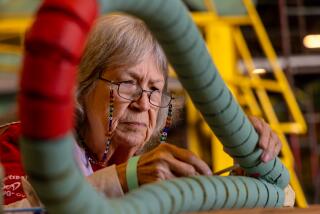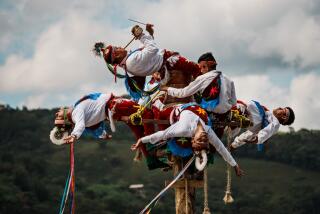Sky-Sailing : Pair of Balloon Makers Offer Something Special in the Air
- Share via
“A calm delight which is inexpressible and which no other situation on earth could give.”
--Balloon pilot Vincenzo Lunardi, 1784
For the record:
12:00 a.m. Dec. 7, 1989 For the Record
Los Angeles Times Thursday December 7, 1989 Orange County Edition Orange County Life Part N Page 3 Column 5 Life Desk 1 inches; 17 words Type of Material: Correction
Balloonist--A Nov. 16 article incorrectly identified a Costa Mesa balloon manufacturer. His name is Lyle Eckmeier.
While others in Orange County are developing some of the world’s most sophisticated high-tech aerospace equipment, Carl Gage and Lyle Piccard of Costa Mesa are building flying machines based on technology developed more than 100 years before the Wright Brothers flew the first airplane.
“The (hot air) balloon is sophisticated in its simplicity and it really hasn’t changed that much over the years. It is an extremely efficient technological design. It can lift two or three times its own weight and can climb faster than many airplanes,” said Gage, a former Marine Corps corporal.
“Planes are nice if you want to get there fast. But if you really want to look at the world, fly a balloon.”
Orange County is too heavily populated for balloon flights, but nearby boatyards are convenient for construction, since the balloons are made of the same nylon fabric used to make spinnakers for sailboats.
“Ballooning is in many ways closer to sailing than to flying,” Gage said. “I like to call it sky-sailing.”
Gage and Piccard operate AIR, which stands for Aeronaut Instruction & Research, the only commercial balloon manufacturer on the West Coast and one of only six in the nation. They make seven to 12 balloons a year at $15,000 to $30,000 each, depending on the design.
Although AIR builds mostly hot air balloons, it was recently awarded a contract from the Jet Propulsion Laboratory in Pasadena to build a series of helium balloons for meteorological experiments conducted by JPL and the University of Massachusetts.
The balloon structure consists of a network of supporting canvas tapes and cables that extend down and connect to a basket. The support network can be built vertically, horizontally or both--allowing the designer flexibility and creativity in shaping the balloon envelope.
Colorful fabric panels are sewn between the web of support tapes on the shop’s six sewing machines. One of AIR’s more unusual designs was a tomato-shaped balloon created for a pizza parlor chain in the Midwest.
The balloon gondola is made of wicker and rattan, the same materials used in the first balloons more than 200 years ago. “You need something strong enough to carry passengers, but with enough give and flexibility not to injure them in a rough landing,” Gage said.
Rattan is used for the larger portions of the basket and wicker for the small spaces in between. The reeds are soaked in a tub behind the shop and hand-woven around a frame with a metal bottom that serves as a platform for passengers. Portions of the basket are reinforced and padded with suede. Removable tanks of liquid propane gas are fitted inside the basket and hooked up to a detachable stainless steel burner, used to heat the air inside the balloon.
Working together, Gage and Piccard can build a balloon in a month, but the work can be completed in just over a week with a few extra helpers at the sewing machines.
“You are working with over 1,000 yards of fabric, and even though you have traced the patterns onto paper and cut the fabric panels around them and sewn it all up, you still don’t know exactly what you have until you blow it up, and by then it’s five stories tall,” Piccard said. “My mother taught me to sew them and fly them.”
Piccard’s mother, Willie, held American balloon-flying records in the 1970s. His stepfather, Don Piccard, built balloons out of a sailboat loft in Newport Beach for almost 30 years and is credited with developing hot air ballooning as a sport in the United States.
Piccard is the son of scientists Jean and Jeannete Piccard, who were among the first to conduct manned balloon flights into the stratosphere in the 1930s. The experiments delivered information about cosmic rays and the effects of high-altitude flight.
The balloon-making business keeps Gage and Piccard busy but not rich; both work nearly full time in other occupations. Piccard is an industrial designer and Gage works three days a week as an engineer at Channel 22’s transmitter facility on Mt. Wilson near Los Angeles.
Both are certified balloon-flying instructors and offer rides on weekends in Temecula, Palm Springs, Paso Robles and Perris Valley. Gage even offers instruction in flying airships like the Goodyear blimp. He designs and sells commemorative pins, which he enthusiastically hands out to his passengers and ground crew.
The pins, along with customary champagne toasts at the end of balloon rides, are not a new gimmick. They are a carry-over from the days when the first balloonists met up with hostile peasants in the countryside when forced to make emergency landings.
“The country people were frightened of the balloons and attacked them with pitchforks. The balloonists calmed them down with champagne and trinkets,” Gage said.
Gage’s involvement in ballooning has shaped his life in the mold of early barnstormer pilots and balloonists who flew from town to town, landing in farm fields and offering rides to those who gathered around.
Most of his weekends are similar to one recently spent in Paso Robles, where he offers balloon rides at Paso de Robles Winery.
Gage was trying to get a few extra hours of sleep in quarters set up for him at the winery while his ground crew and passengers, mostly residents of nearby farms, began to gather outside at 4:30 a.m. Gage had pulled over en route from Costa Mesa to Paso Robles earlier in the evening and spent part of the night sleeping in another mobile portion of his balloon business--a converted bread truck and small trailer so whimsically painted they resemble a gypsy-wagon caravan.
Gage soon appeared in his pilot’s jumpsuit and favorite cap, and started the hourlong task of inflating the balloon with a huge fan. Just after sunup, Gage’s multicolored balloon towered overhead, and a small group was assembled for the first flight. In the distance, about 20 other balloons rose slowly into the air, like bubbles in a glass of flat champagne--all participants in a balloon race at nearby Paso Robles Airport.
As Gage’s balloon floated over hillsides and pastureland, five people he hardly knew were tracking him on land in the former bread truck. The raucous ground crew tossed aside Gage’s dry cleaning to find seats in the truck, drank coffee and blasted his favorite opera tape--Verdi’s “Rigoletto,” while the driver made a trial-and-error effort to find roads parallel to Gage’s course in the air.
“I don’t know why he chose me. I must look responsible,” the driver joked. “Last time he strapped this big walkie-talkie to my chest and told me to say, ‘Ground to balloon commander, come in, come in!’ and here I am driving around in this bread truck or whatever it is. We must look pretty funny or very suspicious. Like some kind of deliberately absurd Drug Enforcement Agency undercover operation.”
The wind picked up and Gage was forced to land in a pasture, or risk blowing off into areas where the ground crew could not reach the stranded balloon. The spectacle attracted a small crowd, residents of nearby homes out for an early morning walk.
“That’s one of the most amazing things I’ve ever done in my life,” said Bill Alberts, a World War II pilot and one of those on the flight. “It’s so quiet up there!”
A disappointed but cheerful group of hopeful passengers was later told there would not be another flight because the wind was still too strong. The balloon was deflated and packed into the small trailer, and the crew, passengers and pilot headed back to the winery for a champagne brunch.
Ballooning has clearly affected Gage’s philosophy of life.
“It takes a certain kind of person to do this. You can’t be obsessed with preconceived destinations. Ballooning trains an individual to adapt to the air and not overpower it. It appeals to a more imaginative and creative type who wants more than common routine. No two flights are ever the same.”
More to Read
Sign up for The Wild
We’ll help you find the best places to hike, bike and run, as well as the perfect silent spots for meditation and yoga.
You may occasionally receive promotional content from the Los Angeles Times.






